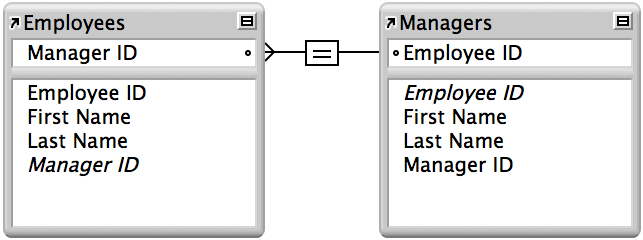Self-joining relationships
A self-joining relationship (or self-join) is a relationship in which both match fields are defined in the same table. FileMaker Pro generates a second occurrence of the table upon which you are basing the relationship in the relationships graph. This prevents the relationship from forming a cycle, which would be impossible to evaluate.
For example, use a self-join in a portal on a layout of the current table to display a subset of data that's in the current table, such as all the employees who report to each manager. In this example, you would use a table named Employees.
To define a self-joining relationship:
- In the relationships graph, select the table to use for the self-joining relationship. Then click
 .
.See Working with the relationships graph and Creating and changing relationships.
- In the Edit Relationship dialog box, for Table, choose the same table for each side of the relationship.
In the example above, choose Employees on both sides of the relationship.
- Select the match field for each table occurrence, define the relationship, click Add, then click OK.
- Type a name for the second table occurrence, then click OK.
For example, rename Employees 2 to Managers.
In the example above, the match fields are Employees:Manager ID and Managers::Employee ID. This relationship returns related records in Employees when the value in Employees::Manager ID is the same as the value in Managers::Employee ID.
This example looks like this in the relationships graph:

For more examples of using a self-join, search the Knowledge Base.
Notes
- You can also select the table in the relationships graph and click
 to create a self-join.
to create a self-join.